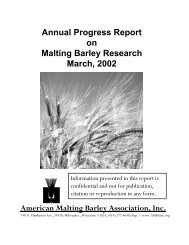Annual Progress Report on Malting Barley Research March, 2007
Annual Progress Report on Malting Barley Research March, 2007
Annual Progress Report on Malting Barley Research March, 2007
You also want an ePaper? Increase the reach of your titles
YUMPU automatically turns print PDFs into web optimized ePapers that Google loves.
Gary Hein in Colorado and Nebraska.<br />
Five malt barleys and ten feed barleys being c<strong>on</strong>sidered for cultivar release were tested<br />
at 4 locati<strong>on</strong>s in Idaho with the cooperati<strong>on</strong> of Phil Bregitzer. Remnant seed from head<br />
selecti<strong>on</strong>s made in 2005 and evaluated for homozygous resistance to RWA, were<br />
grown as plant rows in Aberdeen Idaho in 2006 by Phil Bregitzer to obtain breeders<br />
seed increase. These rows were tested again in 2006 for homozygosity prior to bulking<br />
seed for release.<br />
Three advanced lines of RWA-resistant feed barleys were entered in elite winter barley<br />
nurseries and grown at several locati<strong>on</strong>s in Idaho with the cooperati<strong>on</strong> of D<strong>on</strong> Obert.<br />
These 3 lines are in a Schuyler background each with a different source of RWA<br />
resistance and are being c<strong>on</strong>sidered for cultivar release. A large-scale <strong>on</strong> farm test of<br />
4 winter feed barleys adapted to western Colorado was planted in the fall of 2006.<br />
Heads will be selected for pure seed increase of potential cultivar release.<br />
Ten, winter, feed barley germplasm lines in a Post 90 background with RWA resistance<br />
from 10 sources were screened for homozygosity prior to bulking for pure seed for<br />
germplasm release in <strong>2007</strong>. These lines will be resistant to both RWA and greenbug<br />
and are widely adapted growing successfully as far north as Idaho as well as the<br />
southern great plains.<br />
The timely additi<strong>on</strong> of Dr. Gary Puterka to our research unit in Stillwater has enabled<br />
this project to resp<strong>on</strong>d to the biotypic changes now occurring in RWA populati<strong>on</strong>s in the<br />
barley growing areas of the US. RWA resistance in barley germplasm must be tested<br />
against all biotypes. The need for genetic diversity has never been clearer. Gary<br />
Puterka is currently screening all 43 spring barley germplasm releases (STARS 0601B<br />
– STARS 0643B) to RWA1, RWA2, RWA3, RWA4, and RWA5. Rating is almost<br />
complete and early indicati<strong>on</strong>s are that resistance has held up to all biotypes. Analysis<br />
is <strong>on</strong>going.<br />
The <strong>Barley</strong> Core Collecti<strong>on</strong> (BCC) was screened for bird cherry-oat aphid (BCOA)<br />
resistance using a new screening technique developed at the USDA-ARS in Stillwater.<br />
The screening is actually and adaptati<strong>on</strong> of flat screening tests established for RWA and<br />
greenbug. Under these testing c<strong>on</strong>diti<strong>on</strong>s, normally asymptomatic seedlings become<br />
symptomatic. Morex, used as a susceptible check, died after 3 weeks of infestati<strong>on</strong><br />
while other lines survived. Seedlings were rated using a rating scale of 1-7 with 1=<br />
resistant and 7=dead. Approximately 10% of the 960 accessi<strong>on</strong>s in the BCC survived<br />
the screening and were rescued. All rescued plants were transplanted into pots and are<br />
currently being evaluated for yield and yield comp<strong>on</strong>ents.<br />
Crosses were made and populati<strong>on</strong>s developed for inheritance and genetic diversity<br />
studies for aphid resistance (RWA and greenbug) in barley. Crosses were also made<br />
99
















